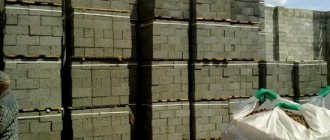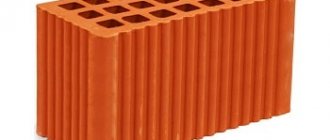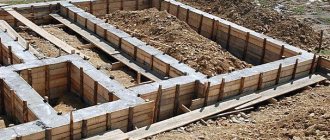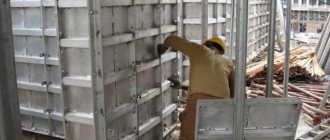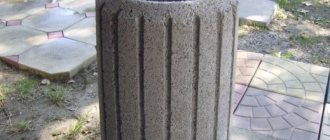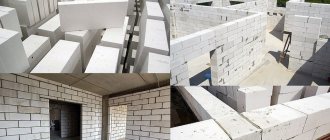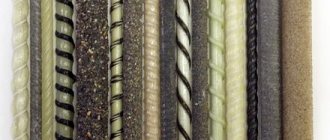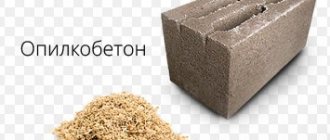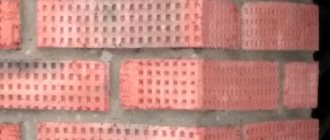For those who have a good idea of what Lego bricks are, this material is attractive not only because of its original name. In many ways, this popularity is based on the opportunity to open the production of Lego bricks at home.
An area of only eighteen to twenty square meters can be a suitable area for placing the necessary equipment and pallets for laying manufactured bricks. After installing all the necessary elements for the production process, there is enough space left in the room for free movement of the operator.
Design and manufacturing features
Building materials are produced using a special machine. The composition of Lego bricks includes screenings of limestone rocks, binding material (usually Portland cement), water, and dyes. Standard dimensions of Lego bricks can be 250x125x65 mm or 300x150x100 mm. Manufactured using hyperpressing method. The quality and reliability of the building material is influenced by the limestone fractions or sand used: the smaller the size of the components, the higher the strength of the finished product. The approximate weight of a Lego brick is 3-3.5 kg.
Manufacturing technology
Making Lego bricks includes the following steps:
- Procurement of raw materials, their sorting and preparation of the required mixture.
- Forming the mixture.
- Pressing of products.
- Storage of finished bricks.
- Wait a certain time before use.
For production, special equipment is required, consisting of the following units:
- loading hopper;
- mixture dispenser;
- a molding chamber with a special matrix located in it;
- electric motor;
- hydraulic press with oil pump.
All equipment is mounted on a metal frame and takes up little space.
When manufacturing products in large volumes, it is recommended to have additional devices for sorting, sifting and mixing raw materials, as well as a conveyor for feeding the mixture into the receiving hopper.
The process consists of the following operations:
- sifting and grinding components;
- thorough mixing of the ingredients;
- the dispensing device sends the required volume to the molding chamber, where the product is formed using a matrix;
- pressing the mixture under pressure created by the oil pump;
- the finished brick is pulled out using a push-out device;
- storing bricks in a warehouse and holding them for ≥ 3 days before sending them to consumers.
Brickwork is done after the products are manufactured, 21 days later.
Technical characteristics of Lego bricks
The widespread use of building materials is justified by the high density and wear resistance of the product. Lego bricks are suitable for finishing work, as well as for the construction of load-bearing walls. This group of bricks has the following characteristics, depending on the manufacturer:
- frost resistance: at least 200 cycles;
- water absorption: about 5-6% (suitable for use in regions with high air humidity and large amounts of precipitation);
- density: 1550 kg/m3;
- thermal conductivity 0.4-0.45 W/(m K);
- strength grade: M100-200 (suitable for the construction of multi-storey private houses or commercial buildings).
Lego bricks are 1.5 times more durable than their ceramic counterparts. The resulting structure is minimally susceptible to mechanical influences and is reliable during periods of seismological influences.
Lego brick production and equipment.
Before starting the cultivation of Lego bricks, it is necessary to adequately assess all the disadvantages and advantages of this method, as well as study all the expenses and costs. It is necessary to realize the full scale of future production, since this industry requires large areas for production. But this is the case when the conversation is about business.
If you make it yourself, you will need to calculate the profitability and decide what will be easier - make it yourself or order it from production.
According to the classical scheme, the ratio of elements in the brick composition is as follows:
- Sand – 10%
- Dropout – 70%
- Cement (M500) – 20%
From 1 ton of this mixture you will get approximately 290 Lego bricks. Costs will depend on the price of materials in your locality. Equipment for the production of Lego bricks is available in large quantities on the CIS construction market.
Equipment for making Lego bricks at home.
To start working, it is enough to purchase a machine (hyperpress), an industrial mixer and other things - molds (matrices), pallets, shovels, etc.
The cost of equipment for brick production depends on productivity:
- machines with low productivity up to 1000 pieces per shift (manual or low power) - 90-300 thousand rubles;
- middle class - about 2000 bricks per shift, price from 350 thousand rubles;
- industrial equipment or a mini plant make it possible to produce more than 750 pieces per hour, but the cost is high - from 2 million rubles.
The brick machine consists of the following parts:
- bunker for bulk materials;
- dispenser;
- matrix for forming Lego bricks;
- pump;
- press;
- bed;
- electric motor (not available in manual units).
Do-it-yourself Lego brick machine.
You can make a machine for creating Lego bricks yourself. Before starting work, it is necessary to prepare certain materials that will become the basis for the machine.
These include:
- channel;
- sheet steel;
- metal corner;
- pipe for creating a handle and piston;
- bolts and nuts.
You will also need a tool. At the very least, a grinder and a welding machine will be useful. The cylinder posts must be made from channel sections, the length of which is approximately 1 m. The width of the cylinder will correspond to the length of the brick being made. Between the racks in the upper part it is necessary to weld two metal rectangles, which will form a section.
Homemade machine for making Lego bricks.
A channel is attached to the resulting structure, the length of which is approximately 0.7 m. It must be positioned with the ribs up. It should be welded on one side, and under the protruding part it should be fastened with supports. After this, a hole is cut above the cylinder, corresponding to its perimeter. The bunker will be welded from sheet metal. It is important that its width and length fully correspond to the dimensions of the final form. The hopper is mounted on 4 legs, the basis of which will be strips of metal welded to the protruding part of the channel. The piston is made from a metal sheet. Two pipes should pass through this rectangle.
From a piece of pipe and metal strips we make a handle with which the lid will open and close. The handle is secured with long bolts. The corner will be needed to make a base for the machine. A homemade machine will allow you to make two types of bricks yourself. It can be either Lego with holes or solid. There is no need to make a matrix. It is much wiser to purchase a ready-made one.
Necessary raw materials for making Lego bricks.
To produce this material, environmentally friendly substances are used. All components are widely used and available. There is no exact recipe for preparing raw materials - the ratio of ingredients depends on the required density and quality.
One of the mixture composition options:
- filler – screening of crushed limestone (up to 90%);
- binder – cement (7-15%);
- water (up to 5%);
- plasticizers;
- dyes.
Comparison of technical characteristics of Lego bricks versus classic ones.
On the Internet you can find many opponents of Lego technology who leave negative reviews. But take a closer look - basically all the shortcomings of Lego bricks are far-fetched and have nothing to do with practice. Most likely, these are the same professionals who are terribly upset about the reduction in prices and the arrival of new people in their business. Let's compare a Lego brick with its regular fired counterpart in terms of basic technical indicators.
| Technical indicator | Lego brick | Red ceramic brick |
| Strength | M150 | M150 |
| Density | 1550 kg/m3 | 1600-1900 kg/m3 |
| Frost resistance | 35-40 cycles | 35-40 cycles |
| Weight | 3 kg | 3.7-4kg |
| Water absorption | 5,5% | 14% |
Data taken from open sources. We took the strength of the brick as a starting point. It may vary depending on the production technology. M150 is the recommended minimum strength for the construction of load-bearing structures.
Conclusion.
Currently, Lego bricks are considered as a new generation material. They are still treated with interest and caution. But increasingly, “Lego” (brick) reviews from builders are receiving positive reviews due to the quality of the material and ease of installation, as well as favorable prices, practicality and impeccable appearance. And these are quite weighty arguments.
Advantages
The positive properties of the material are not its only advantage. The unique shape ensures ease of laying walls or partitions and high-quality connection of elements. The most important advantages of using a new type of brick include:
- Possibility of simple installation of communications inside voids.
- Low cost of products.
- Wide range of colors (from light gray to rich red, dark blue, pink or yellow).
- There is no need for subsequent finishing of walls and structures made of Lego bricks (it has a smooth surface or has edges with a slight texture).
- The low weight of the bricks does not require the preparation of a buried foundation (for buildings of 1-3 floors).
The material is also attractive due to its versatility of use. Suitable for both finishing buildings and laying out decorative indentations and stoves. Can be used for the construction of gazebos and fences.
Implementation of a business idea
This type of brick will be in demand among private owners and government facilities. At the same time, you can sell your products via the Internet, but to do this you need to create your own store. You can sell bricks at a retail facility that specializes in building materials. Naturally, this possibility will need to be agreed upon with the store management. A good option for implementation is sale to construction companies.
You can find out more about how our clients implemented their business by contacting us, as well as by going to the “SUCCESS STORIES” section of our website.
- Author: Dmitry
Rate this article:
- 5
- 4
- 3
- 2
- 1
(0 votes, average: 0 out of 5)
Share with your friends!
Flaws
The disadvantages of Lego bricks include the fact that at the moment there are no branded manufacturers of this building material, unlike aerated concrete and other wall materials. Those. These are mainly garage manufacturers, most of which cannot provide quality certificates. Perhaps the most important drawback is that due to its relative novelty, this building material has not stood the test of time and it is not clear how it will last in 30-50 years.
Construction and decoration using Lego bricks
The rows are connected using a special adhesive. It is applied to the surface of the bricks using a special gun; if necessary, the internal cavities are additionally concreted. Layout of products is easy and does not require special skills of the performer. Before carrying out work, you only need to study detailed video and photo reports from professional craftsmen.
For home craftsmen
Recently, you can increasingly hear about such a building material as Lego brick. Moreover, in most cases, it is very problematic for the consumer to independently understand the advantages and disadvantages of these building modules. Therefore, in order to fill the lack of information, let’s try together to figure out what a Lego brick is and what its main technical characteristics are.
So, a Lego brick or a brick with mutual interlocking in the form of a lock really resembles in appearance the elements of the world-famous designer. As a building material, it was developed several years ago by Latin American students who sought to create a modular building material with a simplified installation system.
The existing design of Lego blocks makes the process of laying them really simple. After all, adjacent modules in this case are fastened together not only with the help of an adhesive solution, but also due to the presence of locking connections, which practically eliminates the possibility of poor-quality masonry. As a result, even a beginner in the construction industry can lay Lego bricks with their own hands (especially in linear sections). And the standard training process usually takes no more than one day.

